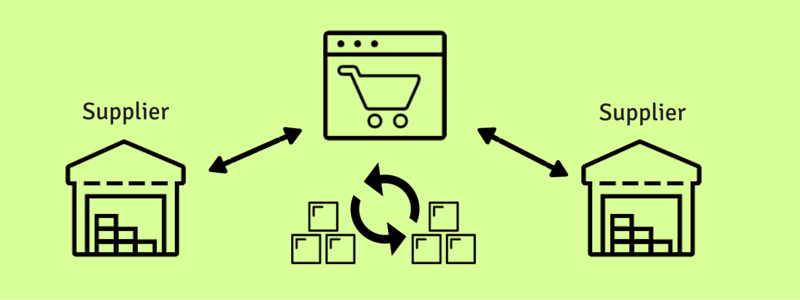Most online retailers will tell you — managing inventory & orders can be a challenge. Traditional retailers have the task of managing the physical inventory. Storing, organizing, packing, and shipping all have their unique and often tedious organizational issues.
Online retailers that choose to sell “dropship” products have a whole new set of challenges they need to deal with. However, their issues lie in the management of the inventory and order data rather than the physical and logistical management that traditional retailers face.
For those that are not familiar — When dropshipping, you do not purchase the products wholesale and physically store the items as traditional retailers often do. Instead you purchase the products individually after an order has been placed on your website. The product is then shipped directly to the end consumer by your supplier, on your behalf, without you ever physically “owning” or storing the item.
You can see how “managing inventory” can mean a much different thing when adding dropship to your supply chain mix. Working with multiple dropship suppliers means extra attention is needed in your inventory & order management processes to ensure you are “in sync” with your suppliers.
Multi-Supplier Integration Points
The two key business processes and integration points that need extra attention when working with multiple dropship suppliers is your Inventory & Order Management.
In the dropship world, “Inventory Management” typically means preventing out of stock sales . There are few things worse in eCommerce than receiving an order for an item and not being able to fulfill on that order. It is essential for dropship retailers to sync their dropship inventory from their supplier’s warehouse system to their online store at least daily to prevent listing out-of-stock items.
In addition to syncing the inventory quantities, dropship retailers that sell from multiple dropship suppliers face a separate set of “multi-vendor management” challenges to ensure the orders are able to be fulfilled efficiently and, most importantly, without error.
The right foundational process for dropship inventory management goes hand in hand with efficient dropship order management. You can’t really have one without the other. Key principles like SKU uniqueness, product overlap management, and data integration, allow online retailers to efficiently route their dropship orders and automatically update their customers with shipment tracking information.
Ensuring SKU Uniqueness
The SKU, which stands for stock keeping unit, still means a lot when you do not hold anything in stock. The SKU is how a single product is uniquely identified for important information such as quantity and price.
The issue here when dropshipping is your supplier “keeps the stock” and therefore is the one that manages the SKU numbers. You could imagine that suppliers are only concerned with ensuring that their own products are uniquely identified, and they would have no way or desire to prevent duplicate SKU numbers from your other suppliers.
The only way to manage this and ensure SKU uniqueness is to have a system. A system we employ at Inventory Source is to prefix SKUs with supplier name initials. This way you can quickly identify whether an SKU is listed from a certain supplier. And, as long as each supplier’s initials are kept unique, it eliminates the possibility of duplicate SKU numbers.
A Quick Example:
Bob’s Distributing has a product identified in their inventory data as SKU123
Dan’s Pet Supplies has a product identified in their inventory data as SKU123
In your online store you will want to avoid duplicates and track two unique SKUs to ensure accurate inventory data and order routing.
So you would prepend the initials for each to be managed as…
Bob’s Product = BDSKU123
Dan’s Product = DPSKU123
No duplicates… simple unique SKUs.
Keeping unique SKUs across suppliers allows retailers to accurately manage inventory quantities, costs, pricing, and other data.
The method of using “supplier initials + the original SKU” makes it simple to identify the supplier associated with the product and also allows you to easily route the product orders to the correct supplier.
There are other methods to ensure SKU uniqueness, but we’ve found that prefixing the SKU with supplier initials to the original SKU allows retailers to quickly identify the supplier and easily determine the original SKU number managed by the supplier — which the supplier will likely require when ordering the product.
For those that setup automated order routing, unique SKUs also ensure that you’re able to set up this routing, confident that orders are being routed with the right products to the correct suppliers.
In the event multiple suppliers carry the same product, aka “Supplier Product Overlap”, this can add another layer of complexity to the inventory management and order routing process.
Supplier Product Overlap
In some cases you may have relationships with multiple suppliers that carry the same product. For an online retailer that’s listing inventory and routing orders to a dropship supplier, this requires more attention and management than the traditional retailer who is simply buying the products wholesale and storing them.
(Image Source: Flickr)
One of the key advantages to dropship is the ability to list more products for sale on your website than you can justify buying wholesale. So it only makes sense to maximize the amount of time your dropship products are listed as “in-stock”. In the scenario of multi-supplier inventory listings, you likely only want one product listing on your ecommerce store to keep a smooth shopping experience for your customer. However, this product listing is being generated and fulfilled by two different vendors who likely have two different stock quantities.
In order to keep your product listing “in-stock” and on your site longer to maximize the chance for a sale, you will want to list the quantity as the sum of the two suppliers’ product quantity data.
The downfall to a “summed inventory” approach is in the event of a “split order” that requires you to ship the product from multiple suppliers to be able to fulfill on the quantity ordered. This means you now have to incur duplicate shipping costs and have the product arrive in two separate boxes, likely at two separate times.
One way to prevent “split orders” is to average the inventory count across the multiple suppliers, eliminating the possibility of a quantity larger than what one supplier can fulfill being listed on the website. This reduces the “in-stock” time this product listing may have on your website, but it can prevent you from fulfilling an unprofitable order or providing a poor customer experience.
Both a “summed” and “averaged” inventory approach will typically require Dropship Automation Software, but this could also be accomplished through spreadsheet functions and manual importing as well.
Cross-Supplier Split Orders
You may be thinking… “okay, well it looks like I can prevent split orders in the event of a single product, but what about in the case of an order with multiple products from multiple suppliers?”
Well, unfortunately there is not much you can do here to prevent this. Most retailers will not want have an online store that prevents items from being ordered together, so this is just a reality of a multi-vendor dropship fulfillment strategy.
One way to try and decrease the probability of this happening is to choose suppliers that carry very different product lines that are less likely to be combined in the same order. Another fairly common method to hedge against the possibility of split orders would be to try and work with larger distributors that carry multiple product lines to reduce the number of suppliers necessary to carry the products you are wanting to list on your website.
The Multi-Supplier Dropship Strategy
There are strong incentives and benefits to building relationships with several different suppliers to work with on a dropship basis. Pricing leverage, product availability, and a larger assortment of products to sell are all reasons why a multi-supplier strategy can make sense for your retail business.
However, when dropshipping across these multiple fulfillment partners, you will need to be aware that, even though you do not have to physically manage the products, there is a data management layer that can take just as much coordination and effort to run your business effectively. A little planning and upfront investment can lead to an effective multi-supplier fulfillment strategy, as well as a strong competitive advantage.
About the Author:
Travis Mariea is the Managing Director at InventorySource.com, the dropship automation software that connects your 3PL or dropship supplier’s inventory and orders with your eCommerce Website and Marketplace Accounts.




